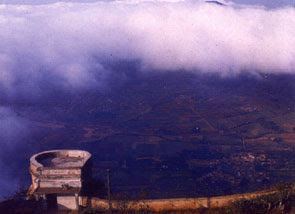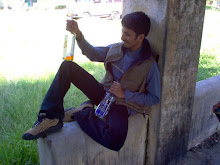
Munnar, also known as the Kashmir of South India is a peaceful hill station with its impeccable beauty has become the most sought after destination for a holiday. Munnar was the erstwhile 'Summer Capital' of the British Government in South India. It is the luxuriant gift of nature to the Western Ghats, the eastern border of Kerala and an adjoining parts of Tamilnadu. Sprawling Tea plantations, picture book towns, winding lanes, and holiday facilities make this a popular resort town
.The very name 'Munnar' means three rivers and there are actually three of them, confluence of three mountain streams-Mudrapuzha, Nallathanni and Kundala
Munnar consists of vast sloping areas of tea. Coffee and cardamom plantations give it a simplistic and smooth appearance. Munnar is a perennial favourite of Indian honeymooners.
Dense forests, wildlife sanctuaries and major cash crop plantations cover most of the region. Among the exotic flora found in the forests and grasslands here is the Neelakurinji. At that time, the hill side will appear bluish in colour. Neelakurinji bathes the hills in blue once every twelve years, will bloom next in 2018AD. For those in Munnar, the blooming of Kurinji flower is a reminder that their lives have gone past another twelve years, and for those from far off; may be it is reminder to witness a once in a life time rare sight of the Kurinji flowers covering the slopes and ravines of Munnar in a blanket of blue.
The hill station of Ooty is known for its orchards of peaches and plums, terraced tea plantations, eucalyptus and pine trees. Ooty hills changes its moods in different seasons, but its different moods provide similar hospitality to the tourists. The hill station sprawling along a picturesque plateau, with its green valleys and natural beauty offer a close affair with nature. Besides its pristine charm, Ooty hills offer several adventure options like trekking, hand-gliding and angling etc.
Ooty is famous for its Tea and Tourism festival, which is held in the month of January. In the festival the visitors can know much about the different flavours of their favorite drink tea. Makar Ponagal is another important festival celebrated in the month of January. One can notice a marvellous change in vegetation, as one goes from Kallar to Coonoor. Lofty mountains, dense forest, sprawling grasslands and miles and miles of tea gardens greet the passengers on most routes. The annual Tea and Tourism Festival attracts crowds in huge numbers.
The Main attractions in Munnar
Anamudi, the highest peak (2695 m) south of the Himalayas, towers over the sanctuary in majestic pride. The slopes of the hills abound in all kinds of rare flora and fauna. The Atlas moth, the largest of its kind in the world, is a unique inhabitant of the park. Other rare species of fauna found here are the Nilgiri Langur, the lion-tailed macaque, leopards, tigers, etc.
An ideal place for trekking, facilities are provided here and tourists are allowed to go on foot up to Anamudi.
Mattupetty Mattupetty is known for its highly specialised dairy farm. -The Indo Livestock Project. Over 100 varieties of high yielding cattle can be seen here. Mattupetty has a beautiful rose garden. The Mattupetty lake and dam is just a shot distance from the farm, is a very beautiful picnic sport. The sprawling tea plantations and the Kundala lake are other attractions in the vicinity. DTPC Idukki provides boating facilities in the Mattupetty dam. Speed launch, slow speed boat and motor boats are available for hire. The famous Eco point is very near and this scenic place gets its name from the natural echo phenomenon here. The Shola forests in and around Mattupetty are ideal for trekking and are habitat to a variety of birds. Rivulets and cascades crisscross the terrain here, which again adds more attraction to the place.
Eravikulam National Park / Rajamala (15km from Munnar) Eravikulam National Park lures the travellers with its irresistible grace and beauty. The 97 sq km park is situated in the Devikulam Taluk is a home to the Nilgiri Tahr, Nilgiri Langur, sambar and the Lion-tailed Macaque. A sanctuary for the endangered mountain goat of South India, the Nilgiri Tahr the Eravikulam National Park stands out for the stark beauty of its rolling grasslands and sholas, spread over 97 sq km in the Rajamalai hills. Rajamala is the natural habitat of Nilgiri Tahr. Half the world population of this rare mountain goat is found here, which is fast becoming extinct.
Potheamedu (6km from Munnar) Pothamedu offers an excellent view of the tea, coffee and cardamom plantations in Munnar. The rolling hills, the cool mountain and the breathtaking scenery here is ideal for trekking and long mountain walks.
Devikulam (7km from Munnar) This small hill station with its velvet lawns, exotic flora and fauna and the cool mountain air . It is a beautiful place with lot of tea plantations. The Sta Devi Lake with its mineral waters and picturesque surroundings is a good picnic spot. The lake is also ideal for trout fishing.
Nyayamakad, Chithiripuram and Lock Heart Gap Nyayamakad, Chithiripuram and Lock Heart Gap are other most attractive places located around 10-12 Kilometers from Munnar. Located beween Munnar and Rajamala, Nyayamakad is a land of scintillating waterfalls. The waters cascade down a hill from a height of about 1600 meters. The enchanting surroundings makes an excellent picnic spot and ideal trekking point..
A small village with sleepy little cottages, bungalows, old playgrounds and courts. That is
Chithirapuram. Chithiripuram still reminds us of an old world charm. Home of the Pallyvasal hydel power project, this hill town is also famous for its picturesque tea plantations.
Lock Heart Gap is an ideal place for adventure tourism and trekking. The fresh mountain air, the mist clad hills and panoramic view make it worthy of a visit.
Anayirangal a lush green carpet of tea plants. A trip on the splendid reservoir is an unforgettable experience. The Anayirangal dam is surrounded by Tata Tea plantations and evergreen forests
Aagarrow Tourism
Feb.2008 Issue





